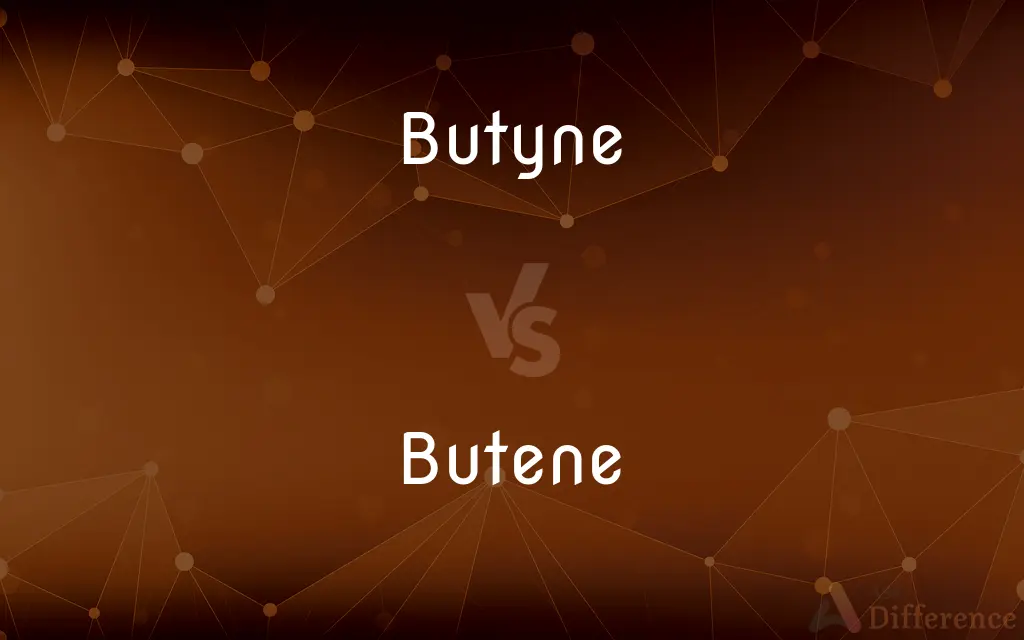Butyne vs. Butene — What's the Difference?
By Tayyaba Rehman & Maham Liaqat — Updated on April 5, 2024
Butyne is a hydrocarbon with a triple bond between carbon atoms, whereas butene contains a double bond.

Difference Between Butyne and Butene
Table of Contents
ADVERTISEMENT
Key Differences
Butyne and butene are both hydrocarbons, meaning they are composed of carbon and hydrogen atoms. Butyne is characterized by having at least one triple bond between two carbon atoms in its structure, which significantly affects its chemical properties and reactivity. On the other hand, butene has at least one double bond between two carbon atoms, making it an alkene, whereas butyne, with its triple bond, is classified as an alkyne.
The presence of a triple bond in butyne gives it distinct chemical properties, such as a higher degree of unsaturation compared to butene. This unsaturation affects reactions such as hydrogenation and polymerization. Butene, with its double bond, participates readily in addition reactions, which are common in the production of polymers and other chemicals.
Butyne exists in different isomers, depending on the position of the triple bond and the arrangement of carbon atoms. Similarly, butene also has isomers that vary based on the position of the double bond and the presence of any branching. These isomers can exhibit different physical and chemical properties.
In industrial and laboratory contexts, butyne is used as a starting material for the synthesis of various chemicals and in welding applications due to its high flame temperature when burned in oxygen. Butene is widely used in the manufacture of polymers, such as polybutene, and as a precursor to other chemicals like butanol.
Despite their similarities as four-carbon hydrocarbons, the key difference between butyne and butene lies in the type of bond (triple vs. double) and the resulting chemical behavior and applications. This distinction influences their roles in chemical synthesis, industrial processes, and physical properties.
ADVERTISEMENT
Comparison Chart
Bond Type
Triple bond between carbon atoms
Double bond between carbon atoms
Classification
Alkyne
Alkene
Reactivity
Higher degree of unsaturation
Less unsaturated than butyne
Industrial Use
Chemical synthesis, welding
Polymer production, chemical precursor
Isomers
Different isomers based on the triple bond position
Isomers vary by double bond position and branching
Compare with Definitions
Butyne
Used in the synthesis of chemicals and in welding for its high flame temperature.
Butyne is utilized in the chemical industry for producing pharmaceuticals.
Butene
Participates in addition reactions, making it useful in chemical manufacturing.
Butene can be hydrogenated to form butane, similar to butyne but through different mechanisms.
Butyne
Highly unsaturated, reacts in specific addition and polymerization reactions.
Butyne undergoes hydrogenation to become butane.
Butene
A hydrocarbon featuring at least one double bond between two carbon atoms.
Butene is used extensively in the polymer industry.
Butyne
A hydrocarbon with at least one triple bond between carbon atoms.
Butyne's triple bond makes it a key molecule in organic synthesis.
Butene
Key in producing polymers and as a chemical building block.
Polybutene, a type of plastic, is manufactured using butene.
Butyne
Existence of isomers depends on the position of the triple bond.
1-Butyne and 2-Butyne are common isomers, differing by the placement of their triple bond.
Butene
Variability in isomers based on the double bond location.
Isobutene is a butene isomer with a more complex branching structure.
Butyne
Boiling points and solubility affected by the triple bond.
The boiling point of butyne varies among its isomers due to differences in bonding.
Butene
Physical characteristics influenced by double bonding and isomer structure.
The boiling point of butene also varies with its isomers, impacting its storage and transport.
Butyne
Butyne is an alkyne that contains 4 carbon and 6 hydrogen.
Butene
Butene, also known as butylene, is an alkene with the formula C4H8. The word butene may refer to any of the individual compounds.
Butyne
(organic compound) Either of two isomeric acetylenes containing four carbon atoms and a triple bond, with the empirical formula (C4H6)
Butene
Any of three gaseous isomeric ethylene hydrocarbons, C4H8, used principally in making synthetic rubbers. Also called butylene.
Butene
(chemistry) Any of several forms of butylene.
Butene
Any of three isomeric singly unsaturated hydrocarbons C4H8; all are used in making synthetic rubbers; - called also butylene.
Butene
Any of three isomeric hydrocarbons C4H8; all used in making synthetic rubbers
Common Curiosities
How are butyne and butene different in terms of chemical reactivity?
Butyne, with its triple bond, is more unsaturated and participates in different chemical reactions compared to butene, which has a double bond.
What is butyne?
Butyne is a hydrocarbon that contains at least one triple bond between carbon atoms.
Can butyne and butene be used interchangeably in industrial applications?
No, their distinct chemical properties mean they are used in different applications; butyne is often used in chemical synthesis, while butene is mainly used in polymer production.
Do butyne and butene have isomers?
Yes, both butyne and butene have isomers, which differ based on the position of the triple or double bond and the arrangement of carbon atoms.
What is butene?
Butene is a hydrocarbon with at least one double bond between two carbon atoms.
How does the industrial use of butyne and butene reflect their chemical properties?
Butyne's use in chemical synthesis and welding reflects its high reactivity due to the triple bond, while butene's role in polymer production highlights its capacity for addition reactions enabled by the double bond.
What are some common uses of butene?
Butene is widely used in the manufacture of polymers and as a precursor to various chemicals.
How does the presence of a double bond in butene affect its properties?
The double bond in butene affects its reactivity and allows it to participate in addition reactions, making it valuable in the production of polymers and other chemicals.
Are butyne and butene found naturally?
Both butyne and butene can occur naturally as part of petroleum gases and are also produced synthetically for industrial uses.
Why is the triple bond in butyne significant?
The triple bond in butyne makes it highly reactive and useful in specific types of chemical reactions, such as addition reactions and polymerization.
Share Your Discovery

Previous Comparison
Closure vs. Closing
Next Comparison
Assume vs. ImagineAuthor Spotlight
Written by
Tayyaba RehmanTayyaba Rehman is a distinguished writer, currently serving as a primary contributor to askdifference.com. As a researcher in semantics and etymology, Tayyaba's passion for the complexity of languages and their distinctions has found a perfect home on the platform. Tayyaba delves into the intricacies of language, distinguishing between commonly confused words and phrases, thereby providing clarity for readers worldwide.
Co-written by
Maham Liaqat















































